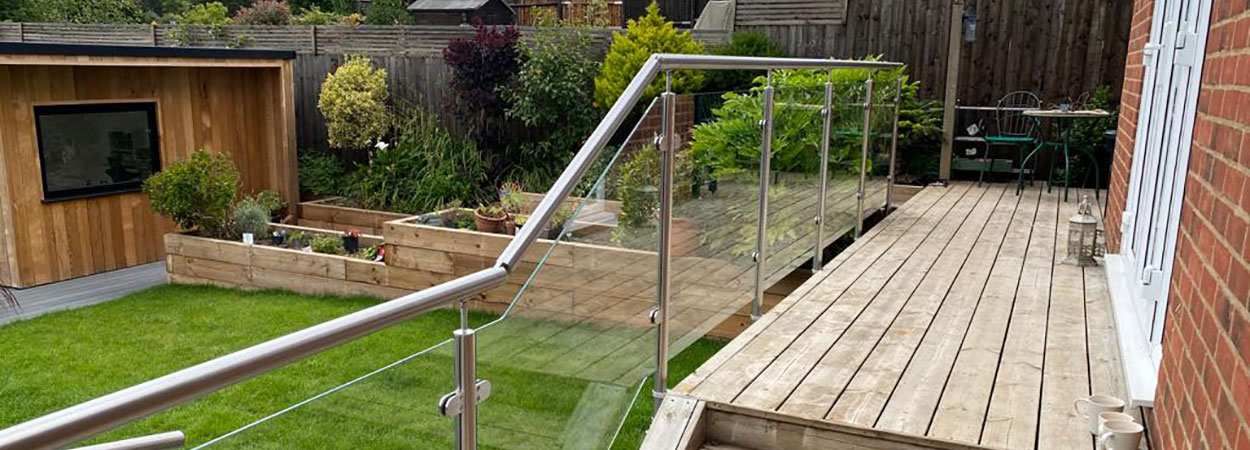
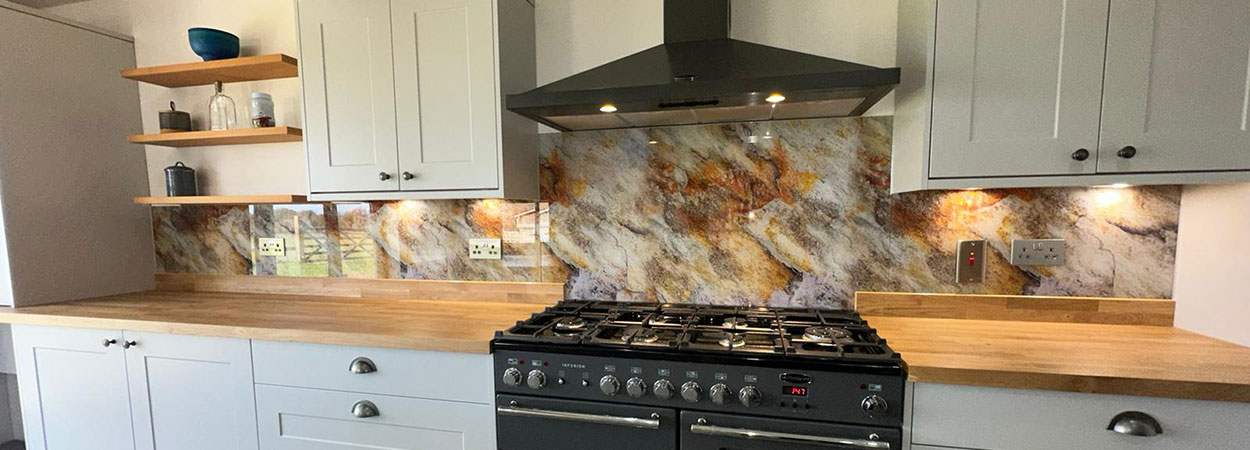
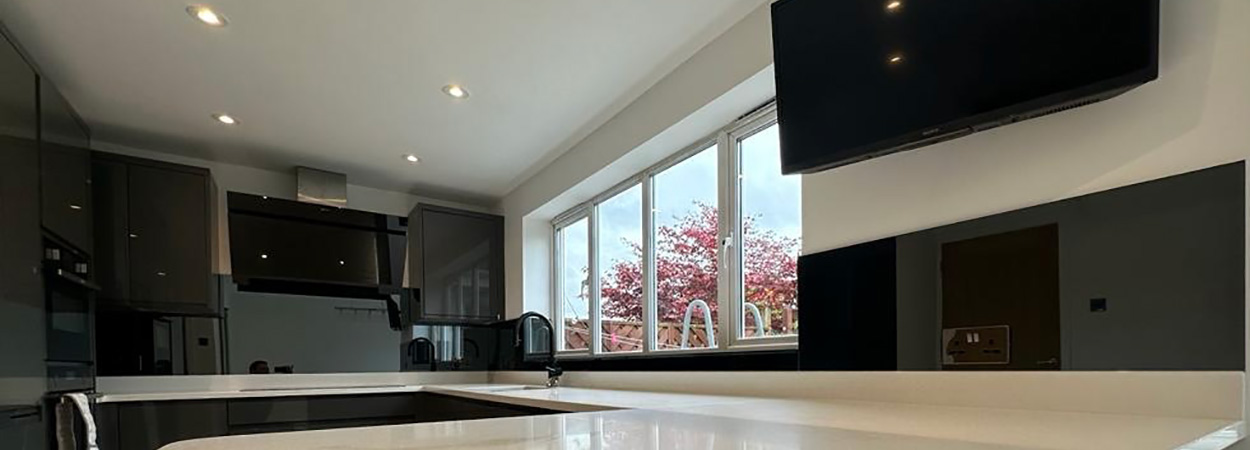
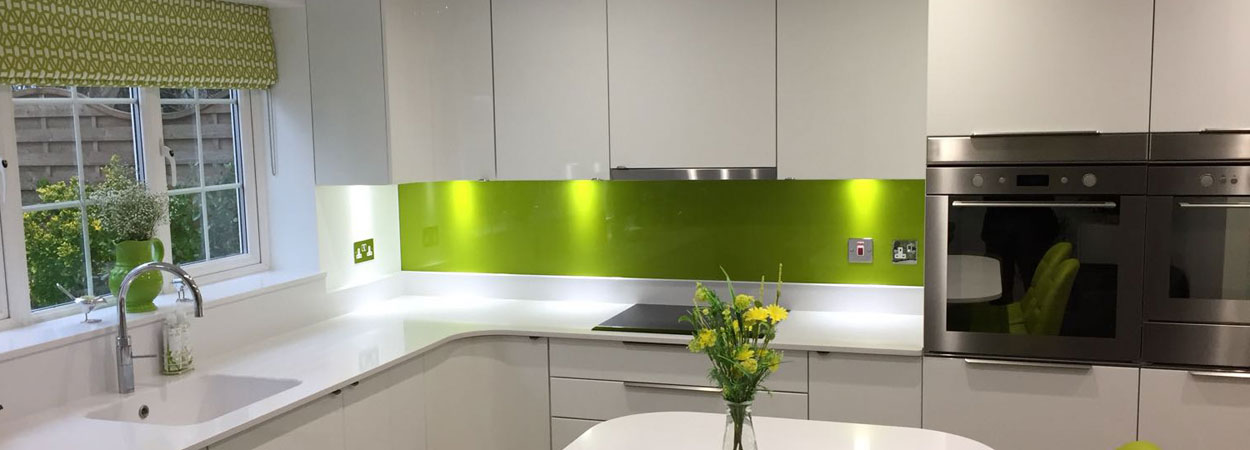
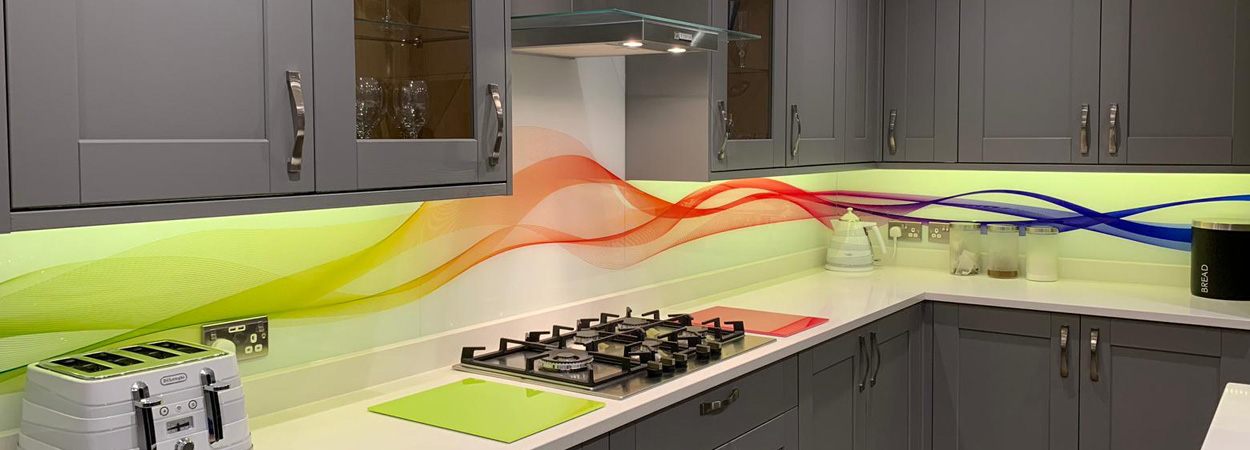
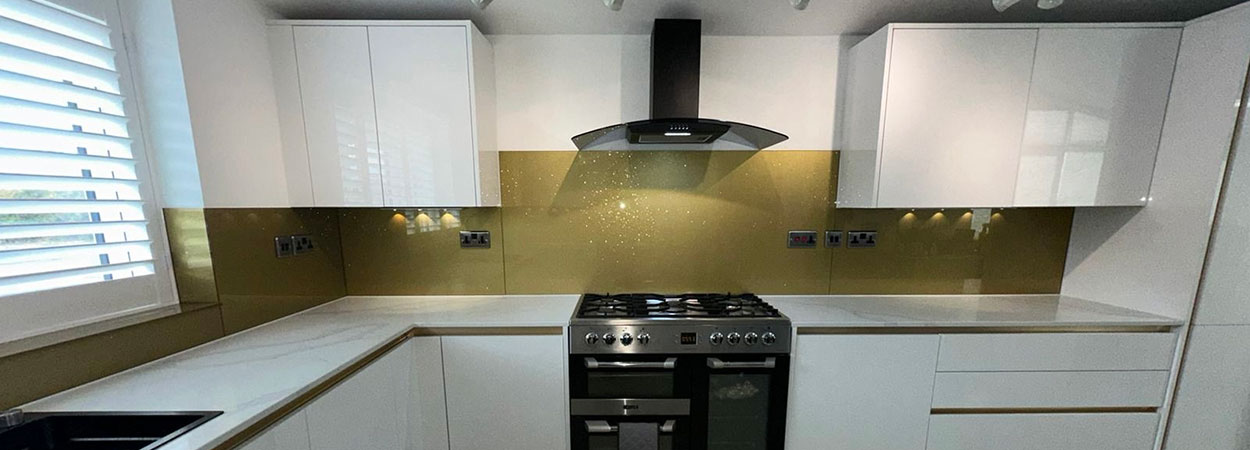


















Glass Splashbacks | Kitchen Splashbacks | Bathroom Splashbacks | Glass Balustrades | Notting Hill, London
Based in Stevenage, Hertfordshire, Splashbacks of Distinction have a real passion for toughened glass in and around the home. We have transformed many properties, both commercial and domestic with our glass splashbacks, for kitchens, bathrooms and living rooms. Our toughened glass balustrades, glass shelving and splashbacks with high resolution images have really caught the imagination of people who demand beauty and functionality in their homes and offices.
Glass splashbacks in Notting Hill
Splashbacks of Distinction are a family run, professional business that is based in Stevenage, Hertfordshire. We cover a wide area, supplying and fitting many different types of glass products and offer many premium glass related services.
Splashbacks of Distinction are happy to visit your Notting Hill property to discuss any glass project you may have. We can help with advice, supply and fitting of your new glass splashback or other glass products.
A little about Notting Hill
The origin of the name Notting Hill is not clear, though an early version appears in the Patent Rolls of 1356 as Knottynghull, while an 1878 text, Old and New London, reports that the name derives from a manor in Kensington called Knotting Bernes, Knutting Barnes, or Nutting barns and goes on to quote from a court record during Henry VIIIs reign that the manor called Notingbarons, alias Kensington, in the parish of Paddington, was held of the Abbot of Westminster. For years, it was thought to be a link with Canute, but it is now thought likely that the Nott section of the name is derived from the Saxon personal name Cnotta, with the ing part generally accepted as coming from the Saxon for a group or settlement of people.
The area in the west around Pottery Lane was used in the early 19th century for making bricks and tiles out of the heavy clay dug in the area. The clay was shaped and fired in a series of brick and tile kilns. The only remaining 19th century tile kiln in London is on Walmer Road. In the same area, pig farmers moved in after being forced out of the Marble Arch area. Avondale Park was created in 1892 out of a former area of pig slurry called the Ocean. This was part of a general clean up of the area which had become known as the Potteries and Piggeries.
The area remained rural until the westward expansion of London reached Bayswater in the early 19th century. The main landowner in Notting Hill was the Ladbroke family, and from the 1820s James Weller Ladbroke began to undertake the development of the Ladbroke Estate. Working with the architect and surveyor Thomas Allason, Ladbroke began to lay out streets and houses, with a view to turning the area into a fashionable suburb of the capital. Many of these streets bear the Ladbroke name, including Ladbroke Grove, the main north south axis of the area, and Ladbroke Square, the largest private garden square in London.
Notting Hill begins its rise in popularity
The Notting Hill houses were rather large, but they did not immediately succeed in encouraging the very wealthy Londoners, who tended to live closer to the centre of London in Mayfair or Belgravia. The houses appealed to the upper middle class, who could live there in a similar style to their Belgravia friends, just at lower prices. In the opening chapter of John Galsworthy's Forsyte Saga novels, he housed the Nicholas Forsytes "in Ladbroke Grove, a spacious abode and a great bargain". In 1862 Thomas Hardy left Dorchester for London to work with architect Arthur Blomfield; during this period he lived in Westbourne Park Villas. He immersed himself in the city's literary and cultural life, studying art, visiting the National Gallery, attending the theatre and writing prose and poetry. His first published story, "How I Built Myself a House", appeared in Chamber's Journal in 1865. Here he wrote his first, but never published novel, The Poor Man and the Lady, in 1867, and the poem "A Young Man's Exhortation", from which Graham Greene took an epigraph for his own novel The Comedians. Arthur Machen, who lived between 1863 and 1947, the author of many supernatural and fictions, lived at 23 Clarendon Road, Notting Hill Gate, in the 1880s; he writes of his life here in his memoirs Far Off Things and Things Near and Far. His mystical work The Hill of Dreams, though written ten years earlier, has scenes set in Notting Hill; it is here that the protagonist Lucian Taylor encounters the beautiful bronze-haired prostitute who will later connive at his death.
Early to the middle of the 20th century in Notting Hill
The reputation of Notting Hill altered over the course of the 20th century. As middle-class households ceased to employ servants, the large Notting Hill houses lost their market and were increasingly split into multiple occupation apartments. During the Blitz a number of buildings were damaged or destroyed by the Luftwaffe, including All Saints' Church, which was hit in 1940 and again in 1944. In the post-war period the name Notting Hill made one think of a rather shabby area of cheap lodgings, epitomised by the racketeering landlord Peter Rachman and the murders committed by John Christie in 10 Rillington Place, which has since been demolished. The area to the north east, Golborne, was particularly known for being, in the words of Charles Booth, "one of the worst areas in London". Southam Street in Kensal Green had 2,400 people living in 140 nine-roomed houses in 1923, and the slum children from this street were documented in the 1950s photographs of Roger Mayne.
In late August and early September 1958, the Notting Hill race riots occurred. The series of disturbances are thought to have started on 30 August when a gang of white youths attacked a Swedish woman, who was married to a West Indian man, following a previous incident in Latimer Road tube station. Later that night a mob of 300 to 400 white people, including many "Teddy Boys", were seen on Bramley Road attacking the houses of West Indian residents. The disturbances, racially-motivated rioting and attacks continued every night until they gradually declined by early September.
The dreadful housing conditions in Notting Hill led Bruce Kenrick to found the Notting Hill Housing Trust in 1963, helping to drive through new housing legislation in the 1960s and found the national housing organisation Shelter in 1966. No's 1-9 Colville Gardens, now known as Pinehurst Court, had become so run down by 1969 that its owner, Robert Gubay of Cledro Developments, described conditions in the buildings as "truly terrible".
The slums were cleared during redevelopment in the 1960s and 1970s when the Westway Flyover and Trellick Tower were built. It is now home to a vibrant community, mainly Mediterranean Spanish and Moroccan, together with Portuguese.
Later improvements to Notting Hill
By the 1980s, single-occupation houses began to return to favour with families who could afford to live there, and because of the open spaces and stylish architecture Notting Hill is today one of London's most desirable areas. Several parts of Notting Hill are characterised by handsome stucco-fronted pillar-porched houses, often with private gardens, notably around Pembridge Place and Dawson Place and streets radiating from the southern part of Ladbroke Grove, many of which lead onto substantial communal gardens. There are grand terraces, such as Kensington Park Gardens, and large villas as in Pembridge Square and around Holland Park. There is also new construction of modern houses tucked away on back land sites.
Since at least 2000, independent shops in Portobello such as Culture Shack have lost out to multinational standardised chains such as Starbucks. In 2009, Lipka's Arcade, a large indoor antiques market, was replaced by the high-street chain All Saints. Reflecting the increasing demise of one of the most culturally vibrant parts of central London, the 2011 Census showed that in the borough of Kensington and Chelsea, in which Notting Hill is situated, the number of Black or Black British and White Irish residents, two of the traditionally largest ethnic minority groups in Notting Hill, declined by 46 and 28 percent respectively in ten years.
Notting Hill adjoins two large public parks, Holland Park and Kensington Gardens, with Hyde Park within one mile to the east. The gentrification has encompassed some streets that were among the 1980s' most decrepit, including the now expensive retail sections of Westbourne Grove and Ledbury Road, as well as Portobello Road's emergence as a top London tourist attraction and Chamberlayne Road as a local shopping street with its boutique independent shops. Notting Hill has a high concentration of restaurants, including the two Michelin-rated The Ledbury and Core by Clare Smyth.
The film with Hugh Grant, named simply 'Notting Hill', created further interest in this part of London and saw an upsurge of the more well to do and fashionable individuals wishing to move into the area.
Splashbacks of Distinction supply the following splashback products in Notting Hill, London
- Glass kitchen splashbacks
- Glass kitchen splashback samples
- Glass kitchen splashbacks in many different colours
- Printed glass splashbacks
- Colour matched splashbacks
- Painted splashbacks
Splashbacks of Distinction also supply the following glass products in Notting Hill, London
- Stainless steel and glass Balustrades
- Glass shelves
- Coloured mirrors
- Toughened mirrors
- Decorative glass
- Glass hardware
- Glass worktops
- Glass shower cubicle
- Garden glass balustrades
- Glass staircases
- Glass table tops
- Satin glass
- Toughened glass
- Laminated glass
- Opaque glass
Splashbacks of Distinction also supply the following glass related services in Notting Hill, London
- Glass cut to size
- Mirrors cut to size while you wait
- Glass processing
- Glass supply and installation
- Supply only splashbacks
- A glass express service
- Template and fit
Only the finest quality from Splashbacks of Distinction
Splashbacks of Distinction ensure that only the finest quality toughened glass is used in all our products. We guarantee all of our work and are fully insured. We employ only trained and certified engineers. Splashbacks of Distinction never leave your property without ensuring you are totally satisfied with your beautiful new glass splashback, baluster, shelving or shower enclosure.
Further Information
If you would like to know more or are interested in a quote we would be happy to help. Phone us on 01920 830 084, email us at enquiries@splashbacksofdistinction.co.uk or fill in our enquiry form and we will be in touch as soon as possible.
Areas covered in London:
- Arkley, London - Kitchen splashbacks | Bathroom splashbacks | Splashbacks with High Resolution Pictures | Glass Balustrades | Glass Shelves | Bespoke Mirrors | Bespoke Shower Screens and Enclosures | Acrylic Splashbacks | Glass splashbacks | Glass Worktops
- Barnet, London - Kitchen splashbacks | Bathroom splashbacks | Splashbacks with High Resolution Pictures | Glass Balustrades | Glass Shelves | Bespoke Mirrors | Bespoke Shower Screens and Enclosures | Acrylic Splashbacks | Glass splashbacks | Glass Worktops
- Battersea, London - Kitchen splashbacks | Bathroom splashbacks | Splashbacks with High Resolution Pictures | Glass Balustrades | Glass Shelves | Bespoke Mirrors | Bespoke Shower Screens and Enclosures | Acrylic Splashbacks | Glass splashbacks | Glass Worktops
- Beckton, London - Kitchen splashbacks | Bathroom splashbacks | Splashbacks with High Resolution Pictures | Glass Balustrades | Glass Shelves | Bespoke Mirrors | Bespoke Shower Screens and Enclosures | Acrylic Splashbacks | Glass splashbacks | Glass Worktops
- Bermondsey, London - Kitchen splashbacks | Bathroom splashbacks | Splashbacks with High Resolution Pictures | Glass Balustrades | Glass Shelves | Bespoke Mirrors | Bespoke Shower Screens and Enclosures | Acrylic Splashbacks | Glass splashbacks | Glass Worktops
- Bethnal Green, London - Kitchen splashbacks | Bathroom splashbacks | Splashbacks with High Resolution Pictures | Glass Balustrades | Glass Shelves | Bespoke Mirrors | Bespoke Shower Screens and Enclosures | Acrylic Splashbacks | Glass splashbacks | Glass Worktops
- Bexley, London - Kitchen splashbacks | Bathroom splashbacks | Splashbacks with High Resolution Pictures | Glass Balustrades | Glass Shelves | Bespoke Mirrors | Bespoke Shower Screens and Enclosures | Acrylic Splashbacks | Glass splashbacks | Glass Worktops
- Bexley Heath, London - Kitchen splashbacks | Bathroom splashbacks | Splashbacks with High Resolution Pictures | Glass Balustrades | Glass Shelves | Bespoke Mirrors | Bespoke Shower Screens and Enclosures | Acrylic Splashbacks | Glass splashbacks | Glass Worktops
- Blackheath, London - Kitchen splashbacks | Bathroom splashbacks | Splashbacks with High Resolution Pictures | Glass Balustrades | Glass Shelves | Bespoke Mirrors | Bespoke Shower Screens and Enclosures | Acrylic Splashbacks | Glass splashbacks | Glass Worktops
- Bow, London - Kitchen splashbacks | Bathroom splashbacks | Splashbacks with High Resolution Pictures | Glass Balustrades | Glass Shelves | Bespoke Mirrors | Bespoke Shower Screens and Enclosures | Acrylic Splashbacks | Glass splashbacks | Glass Worktops
- Brixton, London - Kitchen splashbacks | Bathroom splashbacks | Splashbacks with High Resolution Pictures | Glass Balustrades | Glass Shelves | Bespoke Mirrors | Bespoke Shower Screens and Enclosures | Acrylic Splashbacks | Glass splashbacks | Glass Worktops
- Bromley, London - Kitchen splashbacks | Bathroom splashbacks | Splashbacks with High Resolution Pictures | Glass Balustrades | Glass Shelves | Bespoke Mirrors | Bespoke Shower Screens and Enclosures | Acrylic Splashbacks | Glass splashbacks | Glass Worktops
- Buckhurst Hill, London - Kitchen splashbacks | Bathroom splashbacks | Splashbacks with High Resolution Pictures | Glass Balustrades | Glass Shelves | Bespoke Mirrors | Bespoke Shower Screens and Enclosures | Acrylic Splashbacks | Glass splashbacks | Glass Worktops
- Camberwell, London - Kitchen splashbacks | Bathroom splashbacks | Splashbacks with High Resolution Pictures | Glass Balustrades | Glass Shelves | Bespoke Mirrors | Bespoke Shower Screens and Enclosures | Acrylic Splashbacks | Glass splashbacks | Glass Worktops
- Camden, London - Kitchen splashbacks | Bathroom splashbacks | Splashbacks with High Resolution Pictures | Glass Balustrades | Glass Shelves | Bespoke Mirrors | Bespoke Shower Screens and Enclosures | Acrylic Splashbacks | Glass splashbacks | Glass Worktops
- Chadwell Heath, London - Kitchen splashbacks | Bathroom splashbacks | Splashbacks with High Resolution Pictures | Glass Balustrades | Glass Shelves | Bespoke Mirrors | Bespoke Shower Screens and Enclosures | Acrylic Splashbacks | Glass splashbacks | Glass Worktops
- Chigwell, London - Kitchen splashbacks | Bathroom splashbacks | Splashbacks with High Resolution Pictures | Glass Balustrades | Glass Shelves | Bespoke Mirrors | Bespoke Shower Screens and Enclosures | Acrylic Splashbacks | Glass splashbacks | Glass Worktops
- Chelsea, London - Kitchen splashbacks | Bathroom splashbacks | Splashbacks with High Resolution Pictures | Glass Balustrades | Glass Shelves | Bespoke Mirrors | Bespoke Shower Screens and Enclosures | Acrylic Splashbacks | Glass splashbacks | Glass Worktops
- Chingford, London - Kitchen splashbacks | Bathroom splashbacks | Splashbacks with High Resolution Pictures | Glass Balustrades | Glass Shelves | Bespoke Mirrors | Bespoke Shower Screens and Enclosures | Acrylic Splashbacks | Glass splashbacks | Glass Worktops
- Clapham, London - Kitchen splashbacks | Bathroom splashbacks | Splashbacks with High Resolution Pictures | Glass Balustrades | Glass Shelves | Bespoke Mirrors | Bespoke Shower Screens and Enclosures | Acrylic Splashbacks | Glass splashbacks | Glass Worktops
- Clapton, London - Kitchen splashbacks | Bathroom splashbacks | Splashbacks with High Resolution Pictures | Glass Balustrades | Glass Shelves | Bespoke Mirrors | Bespoke Shower Screens and Enclosures | Acrylic Splashbacks | Glass splashbacks | Glass Worktops
- Crayford, London - Kitchen splashbacks | Bathroom splashbacks | Splashbacks with High Resolution Pictures | Glass Balustrades | Glass Shelves | Bespoke Mirrors | Bespoke Shower Screens and Enclosures | Acrylic Splashbacks | Glass splashbacks | Glass Worktops
- Croydon, London - Kitchen splashbacks | Bathroom splashbacks | Splashbacks with High Resolution Pictures | Glass Balustrades | Glass Shelves | Bespoke Mirrors | Bespoke Shower Screens and Enclosures | Acrylic Splashbacks | Glass splashbacks | Glass Worktops
- Crystal Palace, London - Kitchen splashbacks | Bathroom splashbacks | Splashbacks with High Resolution Pictures | Glass Balustrades | Glass Shelves | Bespoke Mirrors | Bespoke Shower Screens and Enclosures | Acrylic Splashbacks | Glass splashbacks | Glass Worktops
- Dartford, London - Kitchen splashbacks | Bathroom splashbacks | Splashbacks with High Resolution Pictures | Glass Balustrades | Glass Shelves | Bespoke Mirrors | Bespoke Shower Screens and Enclosures | Acrylic Splashbacks | Glass splashbacks | Glass Worktops
- Dulwich, London - Kitchen splashbacks | Bathroom splashbacks | Splashbacks with High Resolution Pictures | Glass Balustrades | Glass Shelves | Bespoke Mirrors | Bespoke Shower Screens and Enclosures | Acrylic Splashbacks | Glass splashbacks | Glass Worktops
- Elm Park, London - Kitchen splashbacks | Bathroom splashbacks | Splashbacks with High Resolution Pictures | Glass Balustrades | Glass Shelves | Bespoke Mirrors | Bespoke Shower Screens and Enclosures | Acrylic Splashbacks | Glass splashbacks | Glass Worktops
- Eltham, London - Kitchen splashbacks | Bathroom splashbacks | Splashbacks with High Resolution Pictures | Glass Balustrades | Glass Shelves | Bespoke Mirrors | Bespoke Shower Screens and Enclosures | Acrylic Splashbacks | Glass splashbacks | Glass Worktops
- Enfield, London - Kitchen splashbacks | Bathroom splashbacks | Splashbacks with High Resolution Pictures | Glass Balustrades | Glass Shelves | Bespoke Mirrors | Bespoke Shower Screens and Enclosures | Acrylic Splashbacks | Glass splashbacks | Glass Worktops
- Finchley, London - Kitchen splashbacks | Bathroom splashbacks | Splashbacks with High Resolution Pictures | Glass Balustrades | Glass Shelves | Bespoke Mirrors | Bespoke Shower Screens and Enclosures | Acrylic Splashbacks | Glass splashbacks | Glass Worktops
- Fulham, London - Kitchen splashbacks | Bathroom splashbacks | Splashbacks with High Resolution Pictures | Glass Balustrades | Glass Shelves | Bespoke Mirrors | Bespoke Shower Screens and Enclosures | Acrylic Splashbacks | Glass splashbacks | Glass Worktops
- Greenford, London - Kitchen splashbacks | Bathroom splashbacks | Splashbacks with High Resolution Pictures | Glass Balustrades | Glass Shelves | Bespoke Mirrors | Bespoke Shower Screens and Enclosures | Acrylic Splashbacks | Glass splashbacks | Glass Worktops
- Greenwich, London - Kitchen splashbacks | Bathroom splashbacks | Splashbacks with High Resolution Pictures | Glass Balustrades | Glass Shelves | Bespoke Mirrors | Bespoke Shower Screens and Enclosures | Acrylic Splashbacks | Glass splashbacks | Glass Worktops
- Hackney, London - Kitchen splashbacks | Bathroom splashbacks | Splashbacks with High Resolution Pictures | Glass Balustrades | Glass Shelves | Bespoke Mirrors | Bespoke Shower Screens and Enclosures | Acrylic Splashbacks | Glass splashbacks | Glass Worktops
- Hadley Wood, London - Kitchen splashbacks | Bathroom splashbacks | Splashbacks with High Resolution Pictures | Glass Balustrades | Glass Shelves | Bespoke Mirrors | Bespoke Shower Screens and Enclosures | Acrylic Splashbacks | Glass splashbacks | Glass Worktops
- Hammersmith, London - Kitchen splashbacks | Bathroom splashbacks | Splashbacks with High Resolution Pictures | Glass Balustrades | Glass Shelves | Bespoke Mirrors | Bespoke Shower Screens and Enclosures | Acrylic Splashbacks | Glass splashbacks | Glass Worktops
- Hampstead, London - Kitchen splashbacks | Bathroom splashbacks | Splashbacks with High Resolution Pictures | Glass Balustrades | Glass Shelves | Bespoke Mirrors | Bespoke Shower Screens and Enclosures | Acrylic Splashbacks | Glass splashbacks | Glass Worktops
- Harold Wood, London - Kitchen splashbacks | Bathroom splashbacks | Splashbacks with High Resolution Pictures | Glass Balustrades | Glass Shelves | Bespoke Mirrors | Bespoke Shower Screens and Enclosures | Acrylic Splashbacks | Glass splashbacks | Glass Worktops
- Harrow, London - Kitchen splashbacks | Bathroom splashbacks | Splashbacks with High Resolution Pictures | Glass Balustrades | Glass Shelves | Bespoke Mirrors | Bespoke Shower Screens and Enclosures | Acrylic Splashbacks | Glass splashbacks | Glass Worktops
- Havering, London - Kitchen splashbacks | Bathroom splashbacks | Splashbacks with High Resolution Pictures | Glass Balustrades | Glass Shelves | Bespoke Mirrors | Bespoke Shower Screens and Enclosures | Acrylic Splashbacks | Glass splashbacks | Glass Worktops
- Hendon, London - Kitchen splashbacks | Bathroom splashbacks | Splashbacks with High Resolution Pictures | Glass Balustrades | Glass Shelves | Bespoke Mirrors | Bespoke Shower Screens and Enclosures | Acrylic Splashbacks | Glass splashbacks | Glass Worktops
- Highams Park, London - Kitchen splashbacks | Bathroom splashbacks | Splashbacks with High Resolution Pictures | Glass Balustrades | Glass Shelves | Bespoke Mirrors | Bespoke Shower Screens and Enclosures | Acrylic Splashbacks | Glass splashbacks | Glass Worktops
- Highgate, London - Kitchen splashbacks | Bathroom splashbacks | Splashbacks with High Resolution Pictures | Glass Balustrades | Glass Shelves | Bespoke Mirrors | Bespoke Shower Screens and Enclosures | Acrylic Splashbacks | Glass splashbacks | Glass Worktops
- Hillingdon, London - Kitchen splashbacks | Bathroom splashbacks | Splashbacks with High Resolution Pictures | Glass Balustrades | Glass Shelves | Bespoke Mirrors | Bespoke Shower Screens and Enclosures | Acrylic Splashbacks | Glass splashbacks | Glass Worktops
- Hornchurch, London - Kitchen splashbacks | Bathroom splashbacks | Splashbacks with High Resolution Pictures | Glass Balustrades | Glass Shelves | Bespoke Mirrors | Bespoke Shower Screens and Enclosures | Acrylic Splashbacks | Glass splashbacks | Glass Worktops
- Hounslow, London - Kitchen splashbacks | Bathroom splashbacks | Splashbacks with High Resolution Pictures | Glass Balustrades | Glass Shelves | Bespoke Mirrors | Bespoke Shower Screens and Enclosures | Acrylic Splashbacks | Glass splashbacks | Glass Worktops
- Ilford, London - Kitchen splashbacks | Bathroom splashbacks | Splashbacks with High Resolution Pictures | Glass Balustrades | Glass Shelves | Bespoke Mirrors | Bespoke Shower Screens and Enclosures | Acrylic Splashbacks | Glass splashbacks | Glass Worktops
- Islington, London - Kitchen splashbacks | Bathroom splashbacks | Splashbacks with High Resolution Pictures | Glass Balustrades | Glass Shelves | Bespoke Mirrors | Bespoke Shower Screens and Enclosures | Acrylic Splashbacks | Glass splashbacks | Glass Worktops
- Kensington, London - Kitchen splashbacks | Bathroom splashbacks | Splashbacks with High Resolution Pictures | Glass Balustrades | Glass Shelves | Bespoke Mirrors | Bespoke Shower Screens and Enclosures | Acrylic Splashbacks | Glass splashbacks | Glass Worktops
- Lewisham, London - Kitchen splashbacks | Bathroom splashbacks | Splashbacks with High Resolution Pictures | Glass Balustrades | Glass Shelves | Bespoke Mirrors | Bespoke Shower Screens and Enclosures | Acrylic Splashbacks | Glass splashbacks | Glass Worktops
- Loughton, London - Kitchen splashbacks | Bathroom splashbacks | Splashbacks with High Resolution Pictures | Glass Balustrades | Glass Shelves | Bespoke Mirrors | Bespoke Shower Screens and Enclosures | Acrylic Splashbacks | Glass splashbacks | Glass Worktops
- Mill Hill, London - Kitchen splashbacks | Bathroom splashbacks | Splashbacks with High Resolution Pictures | Glass Balustrades | Glass Shelves | Bespoke Mirrors | Bespoke Shower Screens and Enclosures | Acrylic Splashbacks | Glass splashbacks | Glass Worktops
- Mitcham, London - Kitchen splashbacks | Bathroom splashbacks | Splashbacks with High Resolution Pictures | Glass Balustrades | Glass Shelves | Bespoke Mirrors | Bespoke Shower Screens and Enclosures | Acrylic Splashbacks | Glass splashbacks | Glass Worktops
- Mortlake, London - Kitchen splashbacks | Bathroom splashbacks | Splashbacks with High Resolution Pictures | Glass Balustrades | Glass Shelves | Bespoke Mirrors | Bespoke Shower Screens and Enclosures | Acrylic Splashbacks | Glass splashbacks | Glass Worktops
- Northolt, London - Kitchen splashbacks | Bathroom splashbacks | Splashbacks with High Resolution Pictures | Glass Balustrades | Glass Shelves | Bespoke Mirrors | Bespoke Shower Screens and Enclosures | Acrylic Splashbacks | Glass splashbacks | Glass Worktops
- Peckham, London - Kitchen splashbacks | Bathroom splashbacks | Splashbacks with High Resolution Pictures | Glass Balustrades | Glass Shelves | Bespoke Mirrors | Bespoke Shower Screens and Enclosures | Acrylic Splashbacks | Glass splashbacks | Glass Worktops
- Penge, London - Kitchen splashbacks | Bathroom splashbacks | Splashbacks with High Resolution Pictures | Glass Balustrades | Glass Shelves | Bespoke Mirrors | Bespoke Shower Screens and Enclosures | Acrylic Splashbacks | Glass splashbacks | Glass Worktops
- Pinner, London - Kitchen splashbacks | Bathroom splashbacks | Splashbacks with High Resolution Pictures | Glass Balustrades | Glass Shelves | Bespoke Mirrors | Bespoke Shower Screens and Enclosures | Acrylic Splashbacks | Glass splashbacks | Glass Worktops
- Poplar, London - Kitchen splashbacks | Bathroom splashbacks | Splashbacks with High Resolution Pictures | Glass Balustrades | Glass Shelves | Bespoke Mirrors | Bespoke Shower Screens and Enclosures | Acrylic Splashbacks | Glass splashbacks | Glass Worktops
- Richmond, London - Kitchen splashbacks | Bathroom splashbacks | Splashbacks with High Resolution Pictures | Glass Balustrades | Glass Shelves | Bespoke Mirrors | Bespoke Shower Screens and Enclosures | Acrylic Splashbacks | Glass splashbacks | Glass Worktops
- Romford, London - Kitchen splashbacks | Bathroom splashbacks | Splashbacks with High Resolution Pictures | Glass Balustrades | Glass Shelves | Bespoke Mirrors | Bespoke Shower Screens and Enclosures | Acrylic Splashbacks | Glass splashbacks | Glass Worktops
- Ruislip, London - Kitchen splashbacks | Bathroom splashbacks | Splashbacks with High Resolution Pictures | Glass Balustrades | Glass Shelves | Bespoke Mirrors | Bespoke Shower Screens and Enclosures | Acrylic Splashbacks | Glass splashbacks | Glass Worktops
- St Johns Wood, London - Kitchen splashbacks | Bathroom splashbacks | Splashbacks with High Resolution Pictures | Glass Balustrades | Glass Shelves | Bespoke Mirrors | Bespoke Shower Screens and Enclosures | Acrylic Splashbacks | Glass splashbacks | Glass Worktops
- Streatham, London - Kitchen splashbacks | Bathroom splashbacks | Splashbacks with High Resolution Pictures | Glass Balustrades | Glass Shelves | Bespoke Mirrors | Bespoke Shower Screens and Enclosures | Acrylic Splashbacks | Glass splashbacks | Glass Worktops
- Sydenham, London - Kitchen splashbacks | Bathroom splashbacks | Splashbacks with High Resolution Pictures | Glass Balustrades | Glass Shelves | Bespoke Mirrors | Bespoke Shower Screens and Enclosures | Acrylic Splashbacks | Glass splashbacks | Glass Worktops
- Teddington, London - Kitchen splashbacks | Bathroom splashbacks | Splashbacks with High Resolution Pictures | Glass Balustrades | Glass Shelves | Bespoke Mirrors | Bespoke Shower Screens and Enclosures | Acrylic Splashbacks | Glass splashbacks | Glass Worktops
- Tooting, London - Kitchen splashbacks | Bathroom splashbacks | Splashbacks with High Resolution Pictures | Glass Balustrades | Glass Shelves | Bespoke Mirrors | Bespoke Shower Screens and Enclosures | Acrylic Splashbacks | Glass splashbacks | Glass Worktops
- Tottenham, London - Kitchen splashbacks | Bathroom splashbacks | Splashbacks with High Resolution Pictures | Glass Balustrades | Glass Shelves | Bespoke Mirrors | Bespoke Shower Screens and Enclosures | Acrylic Splashbacks | Glass splashbacks | Glass Worktops
- Twickenham, London - Kitchen splashbacks | Bathroom splashbacks | Splashbacks with High Resolution Pictures | Glass Balustrades | Glass Shelves | Bespoke Mirrors | Bespoke Shower Screens and Enclosures | Acrylic Splashbacks | Glass splashbacks | Glass Worktops
- Upminster, London - Kitchen splashbacks | Bathroom splashbacks | Splashbacks with High Resolution Pictures | Glass Balustrades | Glass Shelves | Bespoke Mirrors | Bespoke Shower Screens and Enclosures | Acrylic Splashbacks | Glass splashbacks | Glass Worktops
- Uxbridge, London - Kitchen splashbacks | Bathroom splashbacks | Splashbacks with High Resolution Pictures | Glass Balustrades | Glass Shelves | Bespoke Mirrors | Bespoke Shower Screens and Enclosures | Acrylic Splashbacks | Glass splashbacks | Glass Worktops
- Waltham Forest, London - Kitchen splashbacks | Bathroom splashbacks | Splashbacks with High Resolution Pictures | Glass Balustrades | Glass Shelves | Bespoke Mirrors | Bespoke Shower Screens and Enclosures | Acrylic Splashbacks | Glass splashbacks | Glass Worktops
- West Norwood, London - Kitchen splashbacks | Bathroom splashbacks | Splashbacks with High Resolution Pictures | Glass Balustrades | Glass Shelves | Bespoke Mirrors | Bespoke Shower Screens and Enclosures | Acrylic Splashbacks | Glass splashbacks | Glass Worktops
- Wimbledon, London - Kitchen splashbacks | Bathroom splashbacks | Splashbacks with High Resolution Pictures | Glass Balustrades | Glass Shelves | Bespoke Mirrors | Bespoke Shower Screens and Enclosures | Acrylic Splashbacks | Glass splashbacks | Glass Worktops
- Worcester Park, London - Kitchen splashbacks | Bathroom splashbacks | Splashbacks with High Resolution Pictures | Glass Balustrades | Glass Shelves | Bespoke Mirrors | Bespoke Shower Screens and Enclosures | Acrylic Splashbacks | Glass splashbacks | Glass Worktops

Showroom: Unit 11, Broomhall Farm, Watton At Stone, Hertford SG14 2RN
Splashbacks of Distinction is the trading name of RDC Glass Ltd




